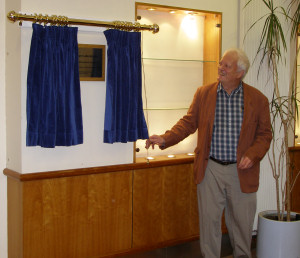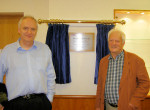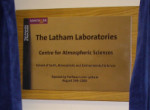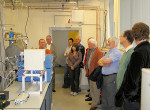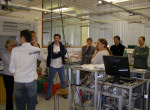Official opening of the Latham Laboratories
On 19th August 2008 the Centre for Atmospheric Sciences new laboratories in the Simon Engineering Building were officially opened by Professor John Latham, and named the Latham Laboratories in honour of Professor Latham's contributions to the atmospheric sciences, particularly in the field of cloud microphysics. Professor Latham who retired in 1988 and is now based in Colorado founded the UMIST Atmospheric Physics Research Group - the forerunner to the Centre for Atmospheric Science - in 1961. During his time at UMIST Professor Latham made significant contributions to the understanding of thunderstorm electrification, warm rain production, and cloud glaciation processes, he also served as head of the UMIST Physics Department on several occasions.
The opening ceremonies began with a lecture given by Professor Latham detailing one of his current research interests - an idea to offset global warming caused by increased CO2 emissions by increasing the reflectivity of marine stratocumulus clouds. While stressing that the most effective way to tackle climate change is by reducing greenhouse gas emissions Professor Latham stated that if shown to be effective such a geoengineering approach may be useful while low carbon energy solutions are developed. The proposed mechanism for this approach is based on the well established effects whereby increasing the number of cloud condensation nuclei entering a cloud increases cloud droplet numbers with a corresponding reduction in droplet diameter. Such a reduction in droplet diameter gives the clouds a greater reflectivity and suppresses the onset of precipitation so enhancing the lifetime of the cloud. CCN would be increased artificially by nebulising sea water using a fleet of wind powered vessels. Preliminary calculations suggested that such an approach could mitigate the warming effect of a doubling in CO2 concentration. However Professor Latham emphasized that considerably more research would be needed, especially to assess any negative impacts such as changes in rainfall distribution, before any such scheme could be put in place.
Following the lecture Professor Latham officially opened the new facilities and unveiled a commemorative plaque. Tours of the main laboratory facilities, including the aerosol chamber, ice chamber, aerosol and UV labs, were then carried out, which were followed by refreshments. The event was attended by approximately sixty people.
Additional Images
Background
After the creation of The University of Manchester from the merger of UMIST and the Victoria University of Manchester in September 2004, the Atmospheric Physics Research Group which was part of the UMIST Physics Department became part of the School of Earth, Atmospheric and Environmental Sciences in the new university. A short time later the group became known as The Centre for Atmospheric Science. As the rest of the school is located in Williamson Building on Oxford Road, some distance away from the Sackville Street Building where the Centre for Atmospheric Science was located, plans were put in place to construct new facilities in the Simon Engineering Building immediately opposite the Williamson Building.
In July and August 2007 the Centre for Atmospheric Science moved into its new facilities spanning five floors within the Simon Engineering Building. These facilities consist of: extensive laboratory facilities including laser and darkroom areas; new cloud chamber facilities; an aerosol chamber; a small roof top area; workshops; and offices for staff and postgraduate students. More information about the new facilities in the Simon Engineering Building may be found here.
